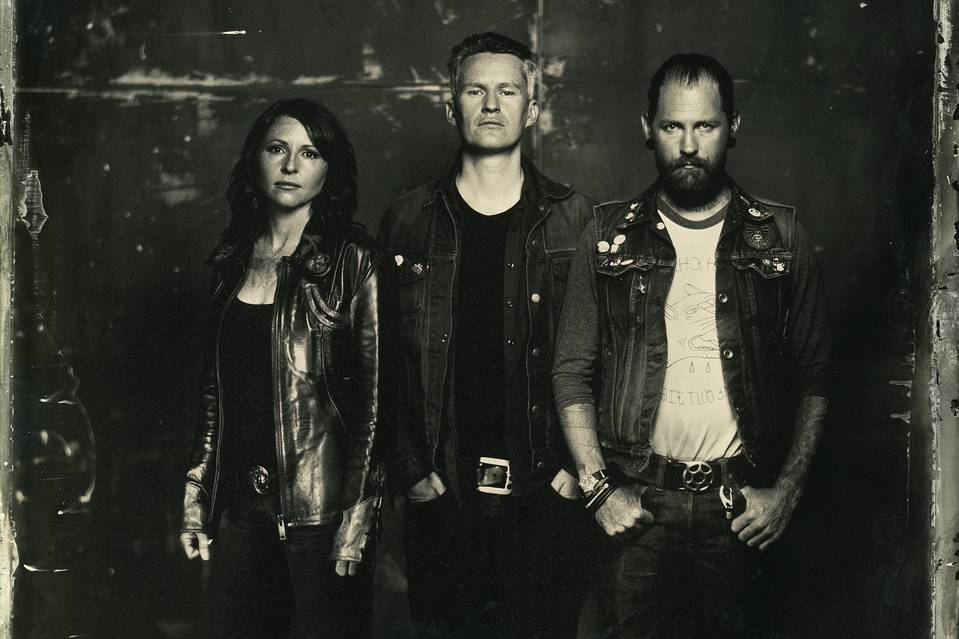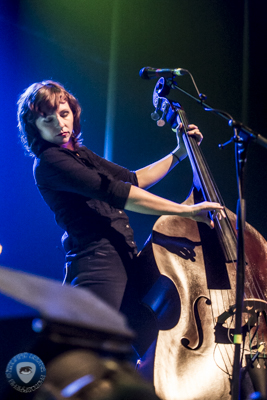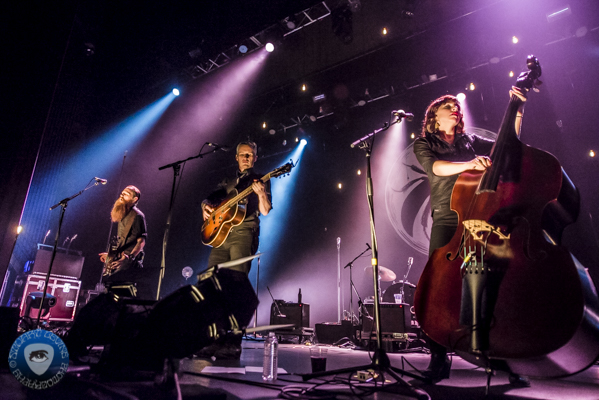The Devil Makes Three: Redemption Songs

Pete Bernhard is onstage at Brooklyn, N.Y.’s Rough Trade for a short matinee performance with his band in support of their new album that dropped a few days earlier. The Devil Makes Three guitarist and lead vocalist is flanked by childhood friend and banjoist Cooper McBean and their longtime bandmate and bassist Lucia Turino. The in-store session marks the soft beginning of their fall tour.
“Instead of being about killing yourself with drugs and alcohol,” Bernhard announces in anticipation of the next song, “This one’s about Jesus.”
The trio then launches into their rendition of “I Am the Man Thomas,” a tune written and originally recorded by bluegrass legend Ralph Stanley, which now finds a home on the “Redemption” side of The Devil Makes Three’s new covers record, Redemption & Ruin. It’s a collection of tracks written by artists ranging from Robert Johnson to Tom Waits, all of whom have influenced the old-timey-punk ethos that TDM3 have curated since the Vermont-by-way-of-California trio officially came together shortly after the turn of the Millennium.
The “Ruin” side of the album doesn’t come as a surprise—throughout the band’s first four studio albums and two raucous live releases, Bernhard has spun tales of drinking, drugs and self-destruction in his songwriting—but the “Redemption” side of things, which draws heavily from gospel tradition, might seem a bit more ill-fitting. But, as Bernhard says, in certain ways, he and his bandmates have been misjudged since the beginning, and they’re just fine with that.
“A lot of times, when we talk to people about our band, they don’t really understand where we’re coming from,” Bernhard says. That misunderstanding might start with appearances— Bernhard and McBean both sport tattoos that cover their left arms, which can be seen when they’re strumming their respective guitar and banjo; McBean dons long hair, a bristly beard and ear gauges; and Turino occasionally reveals a large steer skull tattoo that stretches across her collarbones.
While one might expect some noisy, three-chord punk from such a trio, they instead deliver a hefty dose of rockabilly-influenced twang. “Musically, it’s like a mystery to them,” Bernhard continues. “‘You’re not this and you’re not that—what exactly are you?’ Personally, I think it’s great when you can’t figure out a band because that just means that it’s something different.” 
This clash of styles made for an interesting start to the group’s career. At their early shows, The Devil Makes Three paired with a wide variety of acts as both the band and bookers tried to figure out just exactly where this type of music fit.
“We didn’t know anything about the regular touring scene, the folk music scene or anything like that,” McBean remembers. “Pete had a copy of Book Your Own Fucking Life—a DIY-punk collection of email addresses and phone numbers—so we just started calling people and basically booked punk tours, playing in basements and living rooms between really, really fucking loud bands.”
“I mean, we look like punks,” Turino adds. “So they were sort of like, ‘Alright, get in there.’”
For the most part, the punk scene tended to welcome the folky newcomers. “Some of the time, there were a lot of blank faces—like, ‘What the fuck are these guys doing playing at a hardcore show?’” McBean says. “But the cool thing about the punk scene, at that point at least, is that people tend to have pretty open minds. They’d go to see a hardcore band, but if there was a weird folk band playing, they’re like, ‘Oh, it’s cool.’ Or they’d go out and smoke a cigarette—didn’t matter.”
“In those early days, we played with pretty much anyone who would let us on the stage,” Bernhard adds. “We did some very strange gigs— everything from playing with a thrash-metal band that was on tour in California to playing with a totally Dead-inspired, one-song-is-40-minutes-long kind of band. Really, we’d play with anyone who would give us a chance.”
On the other side of the spectrum, the trio also found themselves on bills with more traditional folk and bluegrass acts, which yielded mixed results from both fans and the bands themselves. “We got more raised eyebrows when we tried to play the super folky shows,” Turino says. “Our music was very influenced by blues and bluegrass and old-time and jazz, but we’re not traditionalists—we’re not good enough to play a lot of that stuff the way it was originally designed to be played—so we made it our own.”
“A lot of the people who were playing bluegrass during that time didn’t really like the fact that we had a drummer,” Bernhard says. “I think we were a little too hard-edged for that scene. We wanted people to dance, and we did a lot of, like, drinking songs. We had a hard time getting shows at first but, later on, it did really help us to gain momentum.”
“But even then, back when we were young, most people were like, ‘It’s good to see young people [playing this music]. It’s great that you guys are even trying,’” Turino says. And despite their unorthodox mash-up of genres, The Devil Makes Three have benefitted somewhat from folk and bluegrass music’s rise in popularity over the past decade and a half. Besides more pop-influenced bands like Mumford & Sons and The Lumineers, the art of traditional bluegrass has been revived and revamped by groups like Old Crow Medicine Show, Yonder Mountain String Band and Greensky Bluegrass, all of whom, like TDM3 themselves, face the challenge of interpreting pre-war music for a modern audience.
“One of the things I hope to do for the tradition in general is to keep the subject matter current, to try to talk about things that are relevant to what’s happening now,” Bernhard says. “It’s our responsibility. Some people stick to the older things—they just stick to the ‘old-timey’ nature of the genre as far as songwriting is concerned. For us, I really try to write songs whose subject matter makes sense and will really grab people who are living on the planet Earth now. It’s the only way we’re going to keep this musical form alive. It can’t just be us playing the songs that people played years ago. That’s not gonna work because, eventually, people just tune out.”
Bernhard credits the Grateful Dead with accomplishing this sort of preservation of classic musical styles for the modern listener, just up the coastline from where The Devil Makes Three first came together in Santa Cruz, Calif.
“Something I really hoped to do with our band was something that happened to me with the Grateful Dead,” Bernhard says. “I listened to the Grateful Dead because I’m from Vermont, and the Grateful Dead is in the water—no one grew up here and didn’t hear them. So, in listening to American Beauty and Workingman’s Dead and Old and in the Way, I got into the music, but then I was like, ‘Wow, where did these songs come from? Who are the artists?’
“The Dead, for me, was almost like a springboard into the music of the past,” Bernhard continues. “I went back there and listened to all these great artists, and it woke me up to the musical history of America. They gave me this inroad. I would love to say that The Devil Makes Three could do the same thing.”
 Part of the impetus for Redemption & Ruin was to open up that portal for a new generation. In taking songs from blues legends like Robert Johnson and Muddy Waters and country songwriting icons like Hank Williams, Kris Kristofferson and Willie Nelson, the album acts as more of a direct quote, as opposed to the paraphrasing presented in past TDM3 efforts.
Part of the impetus for Redemption & Ruin was to open up that portal for a new generation. In taking songs from blues legends like Robert Johnson and Muddy Waters and country songwriting icons like Hank Williams, Kris Kristofferson and Willie Nelson, the album acts as more of a direct quote, as opposed to the paraphrasing presented in past TDM3 efforts.
“One of the reasons for doing this is to point the finger and be like, ‘Hey, our music’s cool, but these are all the people that influenced us, and without these artists, we wouldn’t even exist as a band,’” Bernhard says. “And even though the Grateful Dead isn’t on the album, they are part of the reason why we’ve heard of some of the people who are. That was a big part of listening to the Dead for me—it was almost like a history lesson.”
“It’s just a way to pay tribute to the people we respect,” Turino says of the album’s goal. “Some of it everyone knows— everyone has heard of Hank Williams, and everyone has heard of Kris Kristofferson, whether they know it or not—but, hopefully, it will introduce people to music they may not know.”
But, of course, the band wouldn’t be caught dead simply repeating what someone else has done before. “If you make a cover song and it sounds exactly like the original, then you’ve kinda failed; you’ve missed the point,” Bernhard says.
Redemption & Ruin opens up with a cover of Robert Johnson’s “Drunken Hearted Man,” which The Devil Makes Three transform from Johnson’s sparse mosey into a pulsing, full-bodied onslaught, while the flip side of the record includes an upbeat, church-ready cover of Tom Waits’ originally dirgelike “Come on Up to the House.”
The covers album idea had been floating around the band for a while, and it was even going to be an all-gospel record at one point, but that idea was dismissed as “disingenuous,” as McBean puts it. Instead, the two-sided end product proves to be an outlet featuring an array of songwriters to choose from—along with a mix of guest musicians, which Redemption & Ruin has in spades. That same album opener, for one, features some ripping lap steel from Jerry Douglas, who Turino says came with some of his own arrangements for the song—and who was “a phenomenal player and a wonderful human being.”
Other guests on the album include Emmylou Harris, Tim O’Brien, Old Crow Medicine Show’s Chance McCoy, who adds fiddle to the aforementioned “I Am the Man Thomas,” and Mickey Raphael, who lends an organ-like harmonica to a swampy cover of Townes Van Zandt’s “Waiting Around to Die.”
The Devil Makes Three let all of the musicians choose the track to join in on, something that Bernhard says helped them get the most out of the process. “All the people who played on the record are great, and I didn’t want to constrict them at all,” he says. “There’s no point in taking someone who’s that good and saying, ‘This is what you have to play.’ I wanted them to play something they were into creatively. We left the arrangements really loose in order to make that possible, and it kept the album spontaneous. We were like, ‘Well, we have an arrangement that we wrote four minutes ago—let’s record it,’” Bernhard says, laughing. “That was really fun, and it kept everybody on their toes.”
Besides the all-star mix of guests and songwriters, the themes of Redemption & Ruin are really what are at the forefront on the album—the downward spiral followed by the helping hand lifting you upward. According to Bernhard, “Side A is songs about partying and having fun and drinking and drugs, but also heartbreak and all the things that come along with that. The other side is trying to tell the story of ‘Well, fuck’ and trying to pick up the pieces and put your life back together.”
Although no member of the trio claims to be especially religious, TDM3’s songs have never shied away from the topic. “I think that, for all the problems that I have [with religion], there’s a lot of beautiful and really hopeful art and music that have come out of that,” McBean says. “When you listen to that music, it’s so uplifting, so powerful and charged, and it doesn’t really matter if you’re a believer or not. It’s a visceral, ‘grab-you-by-the-guts’ kind of thing.” 
The themes that run through the “Ruin” side, though, hit a little closer to home for the group. “We’ve known a ton of people who have struggled with addiction and depression,” McBean says. “And I’ve struggled with that in the past, and continue to in other ways. It goes in cycles. You fall down and pick yourself back up—that’s just what life is all about. If anybody ever tells you, ‘I’m always totally bummed out,’ or ‘I’m always super happy,’ they’re fucking lying to you.”
“I’ve certainly gone through my time with drugs and alcohol,” Bernhard agrees. “It’s something I feel like I’ve totally moved past, and I’m happy about that. You have to just decide which way you’re gonna go—is it gonna be the type of thing where it can be an aid to your creativity, or is it gonna be the type of thing that completely takes you o the track?
“I had a friend here in Vermont who always struggled with drugs and alcohol,” Bernhard continues. “He was an instrumental part of how I learned to play the guitar. When we were kids, I would just go over and hang out with him, and we would smoke weed and play songs. A couple years ago, he overdosed and died, and I always knew it was gonna happen. He was pretty out of control when it came to drugs and, if you’ve ever been in that situation with someone, you know you can’t get them to stop; they have to want to stop. He rode that train all the way to the end. Those thoughts [have been] in the foreground for the band in the past couple years. People are dying, people are overdosing, people are losing their way. Some other people are figuring it out, getting through it. Those are really our only two choices.”



















